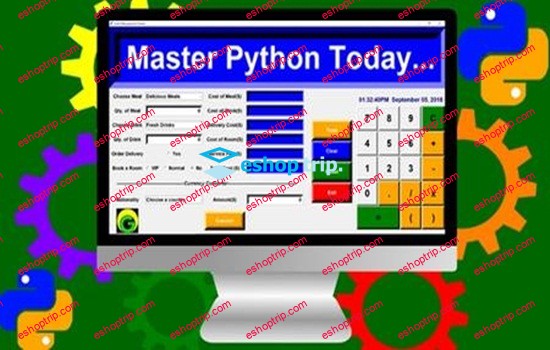Published 1/2023
MP4 | Video: h264, 1280×720 | Audio: AAC, 44.1 KHz
Language: English | Size: 4.92 GB | Duration: 8h 28m
Time Series Analysis in Python: Theory, Modeling: AR to SARIMAX, Vector Models, GARCH, Auto ARIMA, Forecasting
What you’ll learn
Comprehend the need to normalize data when comparing different time series.
Encounter special types of time series like White Noise and Random Walks.
Learn about accounting for “unexpected shocks” via moving averages.
Start coding in Python and learn how to use it for statistical analysis.
Requirements
Beginner data scientists looking to gain experience with time series
People interested in quantitative finance.
Aspiring data scientists.
Programmers who want to specialize in finance.
Description
How does a commercial bank forecast the expected performance of their loan portfolio?Or how does an investment manager estimate a stock portfolio’s risk?Which are the quantitative methods used to predict real-estate properties?If there is some time dependency, then you know it – the answer is: time series analysis.This course will teach you the practical skills that would allow you to land a job as a quantitative finance analyst, a data analyst or a data scientist.In no time, you will acquire the fundamental skills that will enable you to perform complicated time series analysis directly applicable in practice. We have created a time series course that is not only timeless but also:· Easy to understand· Comprehensive· Practical· To the point· Packed with plenty of exercises and resourcesBut we know that may not be enough.We take the most prominent tools and implement them through Python – the most popular programming language right now. With that in mind…Welcome to Time Series Analysis in Python!The big question in taking an online course is what to expect. And we’ve made sure that you are provided with everything you need to become proficient in time series analysis.We start by exploring the fundamental time series theory to help you understand the modeling that comes afterwards.Then throughout the course, we will work with a number of Python libraries, providing you with a complete training. We will use the powerful time series functionality built into pandas, as well as other fundamental libraries such as NumPy, matplotlib, StatsModels, yfinance, ARCH and pmdarima.With these tools we will master the most widely used models out there:· AR (autoregressive model)· MA (moving-average model)· ARMA (autoregressive-moving-average model)· ARIMA (autoregressive integrated moving average model)· ARIMAX (autoregressive integrated moving average model with exogenous variables). SARIA (seasonal autoregressive moving average model). SARIMA (seasonal autoregressive integrated moving average model). SARIMAX (seasonal autoregressive integrated moving average model with exogenous variables)· ARCH (autoregressive conditional heteroscedasticity model)· GARCH (generalized autoregressive conditional heteroscedasticity model). VARMA (vector autoregressive moving average model)We know that time series is one of those topics that always leaves some doubts.Until now.This course is exactly what you need to comprehend time series once and for all. Not only that, but you will also get a ton of additional materials – notebooks files, course notes, quiz questions, and many, many exercises – everything is included.This is the only course that combines the latest statistical and deep learning techniques for time series analysis. First, the course covers the basic concepts of time series:stationarity and augmented Dicker-Fuller testseasonalitywhite noiserandom walkautoregressionmoving averageACF and PACF,Model selection with AIC (Akaike’s Information Criterion)Then, we move on and apply more complex statistical models for time series forecasting:ARIMA (Autoregressive Integrated Moving Average model)SARIMA (Seasonal Autoregressive Integrated Moving Average model)SARIMAX (Seasonal Autoregressive Integrated Moving Average model with exogenous variables)We also cover multiple time series forecasting with:VAR (Vector Autoregression)VARMA (Vector Autoregressive Moving Average model)VARMAX (Vector Autoregressive Moving Average model with exogenous variable)Then, we move on to the deep learning section, where we will use Tensorflow to apply different deep learning techniques for times series analysis:Simple linear model (1 layer neural network)DNN (Deep Neural Network)CNN (Convolutional Neural Network)LSTM (Long Short-Term Memory)CNN + LSTM modelsResNet (Residual Networks)Autoregressive LSTMThroughout the course, you will complete more than 5 end-to-end projects in Python, with all source code available to you.
Overview
Section 1: PYTHON – Introduction to Basics of Python for Beginners
Lecture 1 Python – Data Structures (Lists, Tuple, Dictionary) and String Manipulations
Lecture 2 Python – Implementation Of Lambda, Recursion, Functions.
Lecture 3 Python – Understand Of Libraries,Exploratory Data Analysis,Descriptive Analysis
Section 2: Foundations of Business Statistics for Data Analysis
Lecture 4 Introduction to statistics and Measures of central tendencies
Lecture 5 Central Limit Theorem – CLT
Lecture 6 Distributions and Correlations
Lecture 7 PDF & CDF and Hypothesis Testing
Section 3: TIME SERIES ANALYSIS – Introduction to Basics of Time Series for Beginners
Lecture 8 TIME SERIES – Characteristics and Decomposition of Time Series Data
Lecture 9 TIME SERIES – Best Practices of Probability, Statistics and Forecasting Models
Lecture 10 TIME SERIES – Practical Understanding of Time Series Analysis with Medical Data
Section 4: Capstone Project : UK_Road_Accident_Timeseries_Forecasting_EDA
Lecture 11 UK_Road_Accident_Timeseries_Forecasting_EDA
Lecture 12 Forecast UK Accident rates based on Number of Casualties on SARIMA,FbP,LSTM’s
Aspiring data scientists.,Professional data scientists who need to analyze time series,Deep learning beginners curious about times series
HOMEPAGE
https://anonymz.com/?https://www.udemy.com/course/applied-time-series-analysis-and-forecasting-in-python/











Reviews
There are no reviews yet.